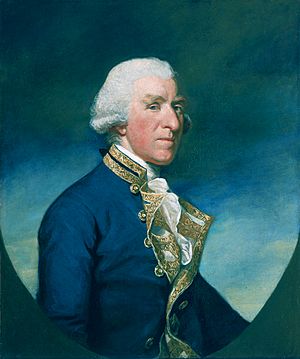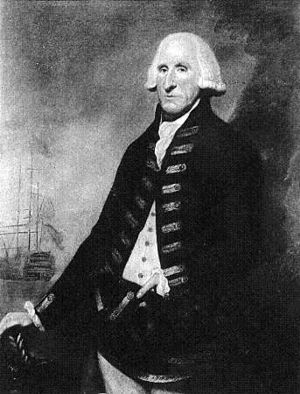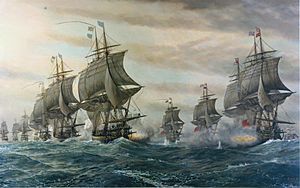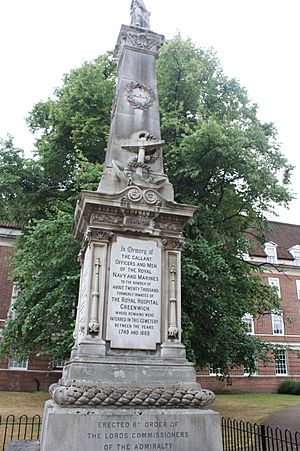Samuel Hood, 1st Viscount Hood facts for kids
Quick facts for kids
The Viscount Hood
|
|
|---|---|

Portrait of Hood by James Northcote
|
|
| Born | 12 December 1724 Butleigh, Somerset, England |
| Died | 27 January 1816 (aged 91) London, England |
| Allegiance | Great Britain |
| Service/ |
Royal Navy |
| Years of service | 1741–1794 |
| Rank | Admiral |
| Commands held |
|
| Battles/wars | |
| Spouse(s) | Susannah Linzee |
| Relations |
|
Samuel Hood, 1st Viscount Hood (born December 12, 1724 – died January 27, 1816) was a famous admiral in the Royal Navy. He started his career as a young officer during the War of the Austrian Succession. Later, during the Seven Years' War in 1757, he took command of Antelope and captured two enemy ships.
Admiral Hood held important positions, including leading the British fleet in North America and the West Indies. He helped the British win the Battle of the Mona Passage in April 1782 during the American Revolutionary War. He also became the head of the Mediterranean Fleet during the French Revolutionary Wars. His younger brother, Alexander Hood, 1st Viscount Bridport, was also an admiral.
Contents
Childhood Dreams
Samuel Hood was the oldest son of Samuel Hood, a vicar (a type of priest) in Butleigh, England. In 1740, a naval captain named Thomas Smith visited their home. He told exciting stories about the sea. These stories inspired Samuel and his younger brother, Alexander, to join the Royal Navy.
Samuel joined the Royal Navy in 1741. He served as a midshipman (a junior officer) and became a lieutenant in 1746. He gained experience in the North Sea during the War of the Austrian Succession. In 1754, he became the commander of a small warship called Jamaica and served in North America.
In 1756, Samuel was promoted to captain. He then became the main captain for Commodore Holmes on Grafton.
Fighting in the Seven Years' War
When the Seven Years' War began in 1756, the navy grew quickly, which was good for Hood. In 1757, while in charge of Antelope, he forced a French ship onto the shore and captured two privateers (private ships allowed to attack enemy ships). His actions impressed the navy leaders.
He was given his own ship, Bideford. In 1759, as captain of Vestal, he captured a French ship called Bellone after a tough fight. He also helped destroy French transport ships that were meant for an invasion of Britain.
After the war, in 1767, he became the Commander-in-Chief of the North American Station. He returned to England in 1770.
American Revolutionary War Service
In 1778, King George III visited Portsmouth and made Hood a baronet (a special title). The war was not popular in Britain. Many admirals did not want to serve under Lord Sandwich, the head of the navy. Admiral Rodney, who was in the West Indies, complained about his officers.
To fix this, the navy promoted Hood to rear-admiral on September 26, 1780. They sent him to the West Indies to be second-in-command under Admiral Rodney. Hood joined Rodney in January 1781 on his main ship, Barfleur. He stayed in the West Indies and North America until the war ended.
Hood and Rodney did not always agree, but Hood always did his duty. He was a very skilled leader.
Battle of the Chesapeake
In 1781, Admiral Rodney went back to Britain for his health. Hood was ordered to take most of the fleet to the North American coast. Hood joined Admiral Thomas Graves in trying to help the army at Yorktown. However, the British fleet was pushed back by the French Admiral de Grasse at the Battle of the Chesapeake.
When Hood returned to the West Indies, he was in charge of the fleet there. Admiral de Grasse attacked the British islands of St Kitts and Nevis with more ships than Hood had. In January 1782, Hood tried to save them. He had 22 ships against 29 French ships. His clever moves, like forcing the French out of their anchorage at Basseterre and fighting off their attacks, were some of the best actions by a British admiral during the war.
Victory at the Saintes
On April 12, 1782, Hood was part of a British fleet led by Admiral Rodney. They defeated a combined French and Spanish fleet that planned to invade Jamaica. The French commander, de Grasse, was captured and taken to Britain as a prisoner.
Chasing the Enemy
Hood was then ordered to chase the remaining enemy ships. With his group of 12 ships, he captured 4 more ships at the Mona Passage on April 19, 1782. This completed the British victory.
While serving in the Caribbean, Hood met and became a mentor to Horatio Nelson, who was then a young captain. Hood also introduced Nelson to the Duke of Clarence, who later became King William IV.
Peace and New Roles

In September 1782, Hood was given a special title: Baron Hood of Catherington. During peacetime, he became a Member of Parliament for Westminster in 1784. He supported the government of William Pitt the Younger.
He became the Commander-in-Chief at Portsmouth in 1786. He was promoted to vice-admiral in 1787. In 1789, he became the First Sea Lord (a very high position in the navy). He returned to command Portsmouth in 1792.
Hood also oversaw the trial of some of the people involved in the Mutiny on the Bounty. Four crew members were found innocent, and six were found guilty. Three of the guilty were pardoned, but the others were executed in 1794.
French Revolution Wars
Defending Toulon
After the French Revolutionary War began, Hood became the Commander-in-Chief of the Mediterranean Fleet in February 1793. In August 1793, French royalists (people who supported the king) took control of Toulon. They invited Hood, whose fleet was nearby, to occupy the city. Hood quickly took command of the port.
Hood occupied Toulon with the help of Spanish and Sardinian forces. However, in December, the allies were forced out, mainly by the military skills of Napoleon. Hood ordered the French fleet to be burned so it would not fall back into the hands of the revolutionary government.
Taking Corsica
Hood then focused on taking Corsica. He was asked to do this by Pasquale Paoli, who had led the Corsican Republic before France took it over. The island became part of King George III's lands for a short time, thanks to the navy and Paoli's help.
While Corsica was being taken, the French at Toulon rebuilt their fleet. Horatio Nelson once said that Hood was "the best Officer, take him altogether, that England has to boast of."
In October, Hood was called back to England. This was due to some disagreement with the navy leaders, which was never fully explained. He was promoted to full admiral on April 12, 1794.
Later Years and Legacy
In 1796, Samuel Hood was given the title Viscount Hood of Whitley. He also received a pension of £2000 per year for life. In 1796, he became the Governor of the Greenwich Hospital, a role he held until he died in 1816. He passed away in Greenwich on January 27, 1816, and is buried there.
His wife, Susannah, was also given a title, Baroness Hood of Catherington, in 1795. Samuel Hood's titles went to his youngest son, Henry.
Several portraits of Lord Hood exist, painted by famous artists like Lemuel Francis Abbott, Joshua Reynolds, and Thomas Gainsborough.
Family Life
In 1749, Samuel Hood married Susannah Linzee. They had children, including:
- Henry Hood, 2nd Viscount Hood (1753–1836), who inherited his father's titles.
Lasting Impact
In 1792, Lieutenant William Broughton, sailing with George Vancouver, named Mount Hood in present-day Oregon and Hood Canal in present-day Washington after Admiral Hood. Port Hood, Nova Scotia, is also named after him.
Two ships of the Royal Navy named HMS Hood were named in his honor. One of these, the battlecruiser HMS Hood (51), was famously sunk by the German battleship Bismarck in 1941 during World War II.
See also
- Alexander Hood, 1st Viscount Bridport, his brother, also an Admiral.
- Sir Samuel Hood (1762–1814), his cousin once removed, a Rear Admiral.
- Horace Hood (1870–1916), a descendant of Admiral Hood, who died in the Battle of Jutland.
- List of ships called HMS Hood



